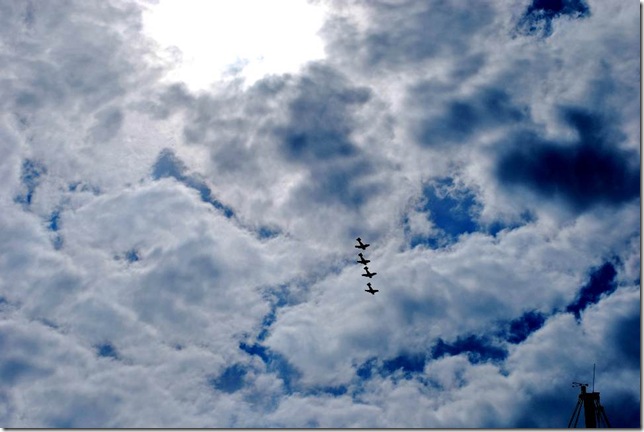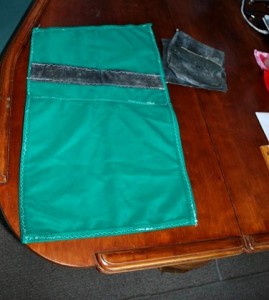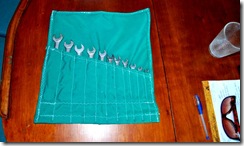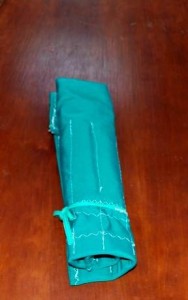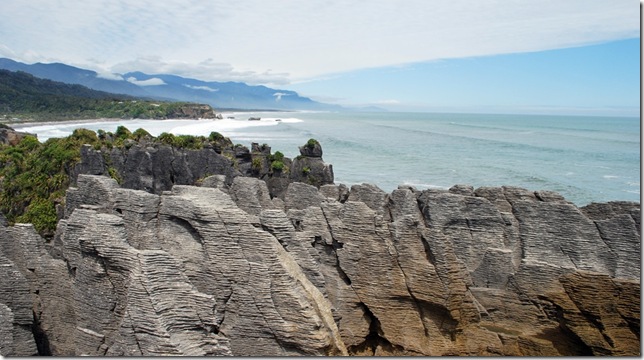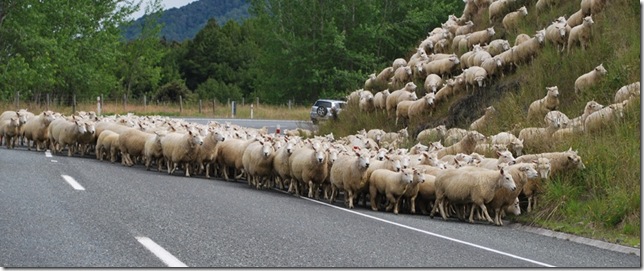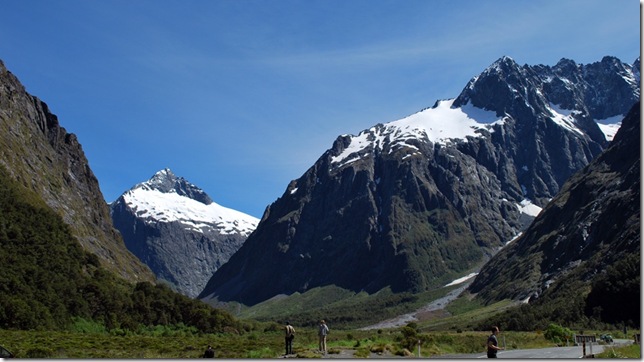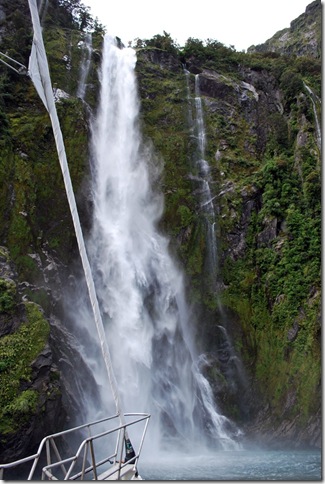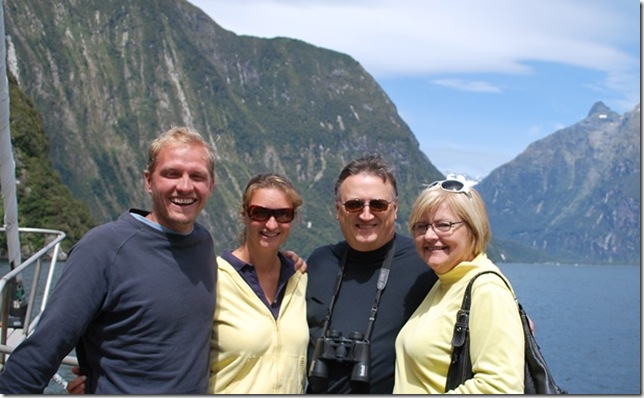I started off the week off being a couch potato for the first time in over a year. My friend Mel kindly let us stay at her place in Auckland even though she was in the States, so after dropping Dallas off at the airport, I returned to get some rest and motivation to drive back to Tauranga. As it turned out, it took several hours to muster it up. It was Waitangi Day, the anniversary of the signing of the Treaty of Waitangi by the Maori chiefs in 1860. The Maori TV network was broadcasting a special program that traced the history of the English representatives’ trip around the country attempting to obtain signatures. Naturally some chiefs were more interested in signing away their sovereignty than others, and much of this appears to have been related to the way in which the treaty was translated to them. Still today, there is no consensus of opinion regarding its implications. One Maori who was interviewed said that the chief of his tribe at the time of the signing was cognizant of the “Great White Wave” (the influx of Europeans) that was coming and found the Treaty with the English to be the best way to ensure ownership of the land. He pointed out that Maoris today fare much better than indigenous peoples of other countries such as the Aborigines in Australia. Their participation in NZ’s coalition government suggests that this is the case. Anyway, I really enjoyed having a chance to just veg out in front of some quality TV, but I would have loved to have been back up in the Bay of Islands that day, as representatives from all the nearby tribes paddled their wakas to the marae for a traditional feast!
Back in Tauranga, I was able to watch the impressive local air show from the marina and catch up with people via email/skype. When I told her it was already Sunday in NZ, my friend remarked, “You mean you’re calling from the future?!”
I’ve hung out with Martin several times this week. I went to watch his team play netball, a game very similar to basketball minus the dribbling and the defense as we know it, since you have to stay 3′ away from other players. The ball (like a volleyball) is passed from player to player until it is in the hands of a designated offensive player who, without someone in their face, can be very leisurely in taking a shot, the catch being that there is no backboard. It was very fast-paced and fun to watch, but it would be more fun to be on a team, so I’ll have to work on that.
I also have managed to make some new friends. Martin and I went to a local pub Monday afternoon to watch The Who (Martin’s favorite band) play at the Super Bowl half-time show, and it was there that I met Matthew, an American pilot, and his wife Goril (pronounced like gorilla without the a), a Norwegian yoga/elementary school teacher. They are trying to establish permanent residence here and seem to have settled in quite well. I feel like they have taken me under their wing by telling me about local activities (e.g., the $2 entry at the hot springs on Mondays), inviting me over for drinks and introducing me to their friends, and last but not least, introducing me to Bikram yoga! I attended my first ever yoga class yesterday, and it was awesome. I was completely unprepared for the experience, though. I showed up without a towel or water and was pretty caught off guard as I walked into the 104 degree room, but Goril was an excellent instructor, providing personalized assistance as needed during the one and a half hour session of intensive stretching and flexing. I have never sweat so much in life, but it was surprisingly invigorating. I can imagine how cathartic it would be after a stressful day. I suppose that’s why some of her students attend class EVERY DAY!
Pura Vida hasn’t changed much since Dallas left, although I relished in completing some odd jobs–installing a bilge pump, tying the trampolines back up, repairing a broken anchor locker hatch, and marking/stowing the newly galvanized anchor chain. I also discovered that sewing might be something I’m capable of under the right conditions, as our machine is much easier to operate now that it has been serviced.
These small tasks pale in comparison to the productivity of the rest of the crew at the moment. Wes landed a 6-month, electrical engineering contract position in Houston, and Tiff is in nursing school there. Dallas is already working 60 hours/week in San Diego and trying to squeeze them into 5 days this week in order to have some time to catch up with good friends of ours in Orange County this weekend. I can’t imagine a more abrupt transition to the working world, but he seems to be doing OK. Tired, but OK.
That’s all for now. I regret not having more photos to include in this blog, but I am uploading the rest of the photos from our excursion to the South Island today, so check them out if you have some free time at work or want some vicarious warmth and sunshine. ;-)
The title of this blog is the only song that I know how to play on the guitar. I learned it in 1998, shortly before or after (can’t remember exactly when) I left to spend a year working as an au pair in Germany, and it has always been special to me. It comes to mind as I write this blog, as Dallas is preparing to fly back to the States on Saturday. He will be working for a former employer in San Diego for the next two months. We are relieved that he has this opportunity to pay our hefty NZ boat repair bills AND ensure that we will in fact get Pura Vida back to the U.S. despite the likelihood of additional costly repairs in the future. Nevertheless, it will be tough to be apart for so long.
I decided to stay here in NZ for a couple of reasons. Obviously, it is costly to fly back ($1,000 minimum), and the chances of getting full-time, short-term work as a psychologist are slim to none. More importantly, there is the work that remains to be done on the boat. Most major repairs are more or less completed, but someone needs to be here to facilitate the mechanic’s evaluation and repair of the port engine (thought to be a transmission problem), and we are overdue for our annual "bottom job". Each time I walk down the dock to the boat and see Pura Vida’s boot-stripe that is now merely speckled with anti-fouling paint along with the collection of dense, dark organic matter that is growing on her hulls, I am reminded of how ready I am to get hauled out of the water and give her "bottom" some TLC. If that isn’t enough motivation, there’s the realization that only these two items stand in our way of heading to Fiji soon after Dallas returns. So as much as it pains me to think of spending so much time away from my husband, the person to whom I’ve had constant access to share adventures, joys, concerns, observations, jokes, complaints, tears, etc. for the last year, it seems like a sensible and worthy sacrifice.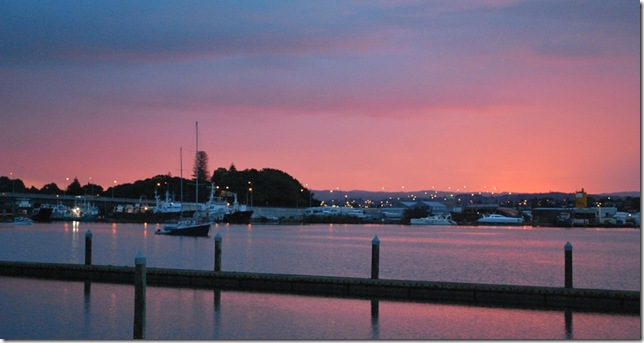
Summer sunset over Tauranga
Dallas has been giving everything a once-over in preparation for his departure, but only occasionally has he reminded me of a parent who is leaving their young child (i.e., boat) with a babysitter for the first time! In fairness, we had originally thought that I would have to sail the boat overnight to Warkworth where there is a travel-lift large enough to haul us out. Undoubtedly this would be a bit of an ordeal for which I would have to recruit a little help from my friends. But it’s looking like there is at least one other feasible alternative (getting taken out with a crane) that would allow me to stay here in Tauranga. An added benefit of staying here is the close proximity to friends like Martin who can keep me from spending way too much time on Facebook!
Speaking of Martin, it has been fun to watch he and Dallas help each other with boat projects, taking advantage of their complimentary skills. Dallas used his electrical engineering skills to repair Martin’s autopilot remote and his sewing machine motor. In turn, Martin helped us by welding a bit of extra length onto our bimini supports and patching up our chafed mainsail cover.
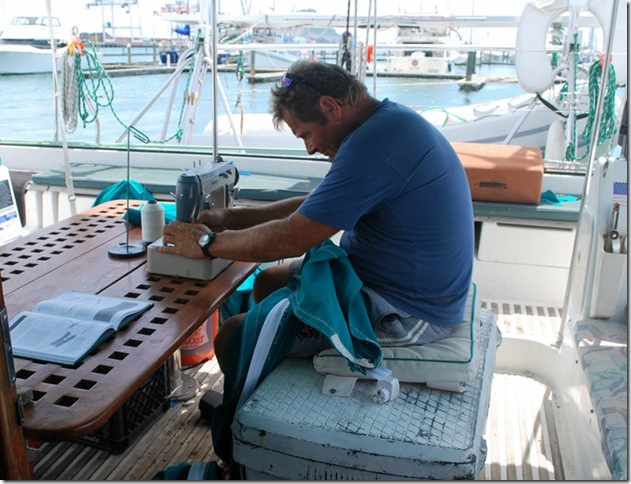
I’m hoping some of Martin’s sewing skills have rubbed off on me. I spent quite a bit of time struggling with our sewing machine in preparation for working on the mainsail cover but ultimately determined that there were problems with the machine beyond its inexperienced operator. I’m looking forward to seeing how we get along now that the “Barracuda” has been serviced, and I have a faint idea of what I’m doing.
For those who are wondering how I will hold up here in NZ in the next couple of months, check the blog. I will be sure to update you on my progress with tasks, local adventures, and overall state of mind!
Yesterday we finally left the boatyard with the bow repairs nearly complete. The good news is that we’ll be all done with a major structural repair after we apply a couple coats of epoxy paint in the anchor locker and tie the trampolines back on. The bad news is that hiring a professional boat builder to do a 3-week repair job isn’t cheap; luckily the lady from the office had me sit down when she called with the final invoice amount. Since they don’t take credit cards (direct account transfers seem to be the way most large transactions are handled here), tomorrow we start the process of trying to make an international wire transfer from overseas. To be fair, the labor rates are less here than in the states, the work was done well, and it was really nice to have a boat builder doing such an important project instead of just a run-of-the-mill boatyard. I spent the last few days working with one of the guys to finish things up, and it really is a lot of slow-going work, especially in the afternoon, when the Kiwi summer sun is out in full force.
For anyone interested in the repair details, our original problem was hull-deck separation on the starboard side of our center “bow” as well as a cracked weld on the fitting that the headstay is anchored to. When the hull and deck separated, the 6 mm through-bolts that held the inboard edge of the starboard tramp either sheared off or pulled through. Even though the boat in general is built like a tank, this particular area wasn’t built as heavily and it’s subject to a lot of stress from pounding into the waves as well as the effects of being doused in salt water frequently. Those three things as well as the age of the boat are probably what contributed to the hull-deck adhesive and two thin layers of glass inside the anchor locker finally giving way. There were a number of steps to the repair, but now we have fresh epoxy with filler in the hull-deck joint gap and six layers of glass on either side of the area that broke loose. Just to be safe, we also added six layers of glass on the inside of the opposite side. All of the eye-bolts that hold the tramps in place were replaced and enlarged as well since they’re bolted through the hull-deck joint. The bow “nose cone”/anchor roller/headstay fitting was removed, re-welded, and beefed up before being carefully replaced by first using release wax on the underside to form an epoxy “male” mated area on the bow to ensure there were no voids to collect moisture. We also took the opportunity to have the rigger replace the bearings in the roller furling as well. They had become so rusted that I had to go out to the roller furling every few days and turn it to break the rust in the bearings loose. If I’d left it more than a week or two, I’m not sure I could have broken them free by hand. It’s been an expensive but productive month so far, and we only have a couple more significant repairs to complete before the repair list is down to a bunch of small stuff.
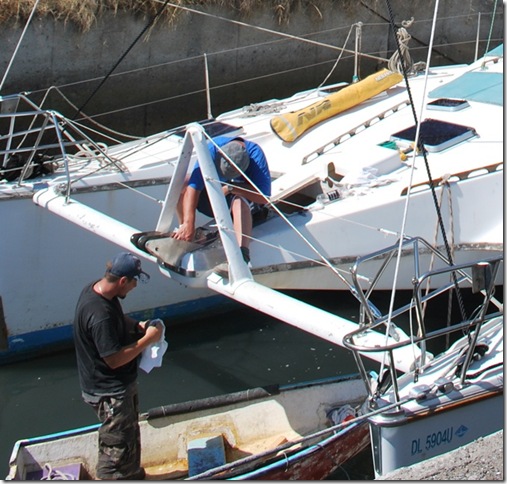 Starting to put things back together
Starting to put things back together
We’ve had a couple people ask us about (non-boat) work. We’re both just slightly too old for the easily acquired unrestricted NZ work visas (we would need a job and a sponsor in advance to get a work visa), and my plans to telecommute from NZ ran into a couple hitches, so we’re currently considering a trip back to the states to add to the kitty, but nothing has been finalized yet.
On a somewhat related note, we’ve also been spending a lot of time contemplating our route back to the US. We budgeted time and money for a 2-year trip via the Suez and Panama Canals, but our later than expected shove-off date led us to alter our plans and spend a season in New Zealand so that we could spend more time in the Pacific Islands. Now we’re left with a couple of options. One option is to take the Suez Canal route as we’d originally planned. The upside to the Suez Canal route is that there’s really a lot to see in terms of different cultures – Thailand, Sri Lanka, the Middle East, Egypt, Turkey, southern Europe, and Morocco. The downsides are the Somali pirates, rough upwind sailing in the Red Sea, poor sailing conditions across the Med, and expensive marinas with few anchorages in southern Europe. The Suez route would also add 8-12 months to our trip due to the need to schedule the trip according to the appropriate seasons. The other option is to cross the southern Indian Ocean and return via South Africa and the Cape of Good Hope. The South Africa route includes several long offshore passages, but goes much quicker due to the way the seasonal timing works out. Aside from visiting fewer countries, the traditional downside to the South Africa route is the area of frequently rough seas south of Madagascar, where numerous circumnavigators have gotten into trouble among the large, confused waves. The potentially rough seas south of Madagascar have us looking at another option as well that would take us north of Madagascar and allow us to see Chagos, Madagascar, and Mozambique while avoiding the southern tip of Madagascar and crossing the Mozambique channel in a fairly short time with a good weather window. I’ve updated the Route page to show the different options so you can get an idea of what the timing and routes would look like. Lauren also uploaded several new albums of NZ pics, so the Photos link has something new to see for the first time in a while.
 Three routes across the Indian Ocean
Three routes across the Indian Ocean
After leaving the boat builder’s slipway at high tide and making the trip back across the river to the marina, we noticed a familiar stern right across from us. The boat Kattywompus, with Brad and Linda from Seattle, had found their way to Tauranga. We’d met them briefly in Ua Pou and enjoyed visiting with them there, and it was nice to see them again several thousand miles and six months later. It turns out they were coming into Opua just as we were leaving and are now on their way to the South Island on their boat. Talking to them reminded us how much we enjoy being on the move, seeing new places, and meeting new people. There’s an old sailing saying that goes “ships and crew rot in port.” So far we’ve managed to avoid both.
We spent the rest of our South Island tour heading up the West Coast and back to where we started in the Marlborough region. Our first stop along the way was the Fox Glacier. This huge mass of ice is about 8 miles long, and this is how far the ice travels over a period of many years from its highest point in the Southern Alps to its terminal face near the coast, where the old ice begins to melt. As we were walking toward the terminal face, we were stopped by a member of the NZ Department of Conservation who told us that large boulder had recently fallen from the mountain into the foot path. She instructed us to be alert, and if we saw one coming, to run as fast as we could! The risk obviously was not so severe as to require them to shut down the area to tourists, but nevertheless, the warning produced some understandably disconcerted expressions on the faces of those for whom running involves considerable effort! We did not in fact see any falling boulders on the way to or from the glacier, but we did have to traverse two creeks that had descended from waterfalls of melting ice. The streams’ paths changed so frequently that the stepping stones that we used on the way to the glacier were covered in water on the way back. The glacier itself has changed quite dramatically as well, though it hasn’t receded as much as most around the world because it faces the strong westerly winds from the Tasman Sea. We were able to get pretty close to the terminal face and were impressed by the visible layers of compressed ice. Apparently the terminal face is comprised of pure hydrogen (the oxygen has been squeezed out). My understanding is that this is why it has a light blue tint to it, whereas the water streaming from it is gray.
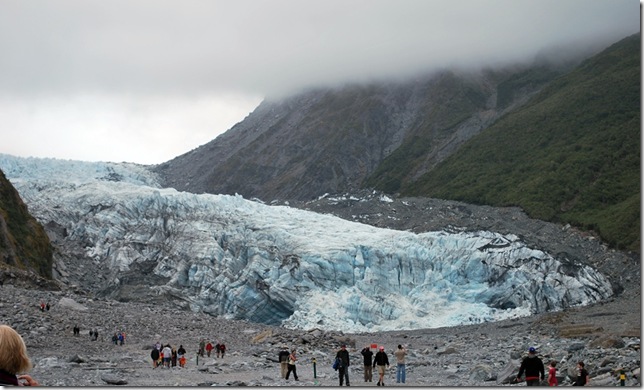 Look at the people on the far left to get a sense of the glacier’s size
Look at the people on the far left to get a sense of the glacier’s size
We continued up through dense rainforest to Greymouth. This quaint town was another former hub for gold mining, and interested tourists can pan for gold at Shantytown, one of the local attractions. We arrived at our B&B after 6:00 and were served traditional tea and biscuits by our hostess Mary, a charming English widow with a bit of a rough edge (her husband was a commercial fisherman). Her house had not been updated in many decades, and she invited us to have a seat in front of the fire into which she shoveled a load of coal. It seemed as though we were back on the vintage steamship for a moment! We went out for a nice dinner at the Speights (“the beer of the Southern man”) Ale House and returned for some TV and political discourse with Mary and her German guest, Wolf.
On our way out of town the next day, we stopped at a local jade (“pounamu” in Maori) gallery, since all four of us had taken an interest in the stone during our travels around the South. Pounamu has been an important part of the culture of Southern Maori tribes for hundreds of years, and to this day these tribes are the only ones permitted to excavate it. We found the studio/gallery of a local artisan, Garth, who was a descendant of one of the tribes and learned to identify and carve the stone from his father. His talent was obvious, as was his passion for the art, and he happily explained the process from start to finish, comparing notes with Dad (a bronze sculptor). Pounamu is a challenging medium because it is so hard—only diamond blades and diamond sand paper will do the trick! Mom and I both left with beautiful pendants, but Maori tradition calls for giving away one’s first piece, so we are just “looking after them” according to Garth.
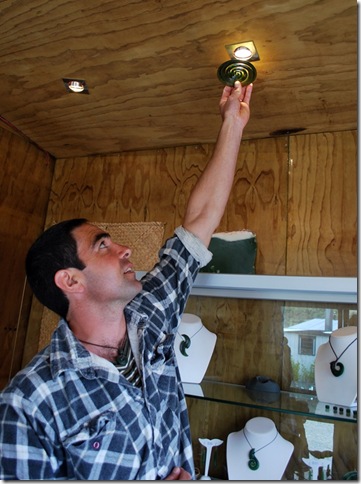 Garth showing us the various shades of green
Garth showing us the various shades of green
Our second stop, just off the motorway, was also quite memorable. The Pancake Rocks are limestone formations along the coast that really do resemble stacks of pancakes. Geologists aren’t 100% sure how they came to be but believe that between layers of limestone there used to be layers of a softer mudstone that was more vulnerable to erosion from waves (hence the gaps between pancakes). However they got there, they make for quite a vista surrounded by rainforest and the rocky coastline!
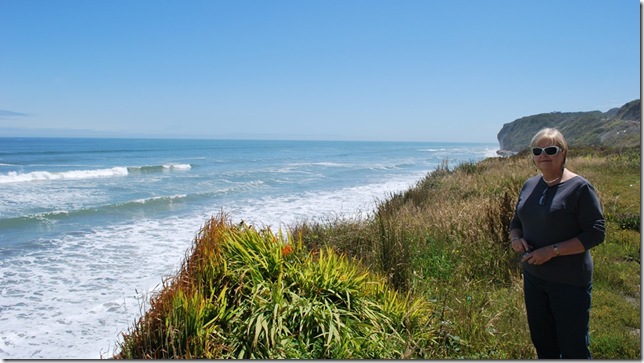 Stopping for a view of the West Coast
Stopping for a view of the West Coast
We followed this coastline on up through dense forest, over the mountain pass, and down into the lovely valleys of the Marlborough region. (Our “caaa” has been put to the test, especially with four lead-foot drivers!) We spent the next four restful nights at a very accommodating B&B in the town of Blenheim, which is making a name for itself as a result of its plentiful vineyards and world-famous Sauvignon Blanc. We set out to sample a few (more like several) over a couple of days and learned about the characteristics and processes used to create the typical white varieties. Our favorites came from the Te Whare Ra (“the house of the sun” in Maori) winery with only four employees, and we took a bottle back to the the sunny yard of the B&B to enjoy along with some goat cheese and fresh bread. What better way to finish off a whirlwind tour? We also visited the Aviation Heritage Museum, home to a bunch of replicas of World War I planes including that flown by the “Red Baron”. Finally, we spent our last day in the South Island in nearby Nelson, a slightly larger city that is known for its arts, food, and its proximity to the beaches of the Abel Tasman National Park. We got a taste of all of this, from the very impressive collections from local and national artists at the public art gallery, to the creative and inexpensive dishes served at the cafe, to the fine white sand of the local beach.
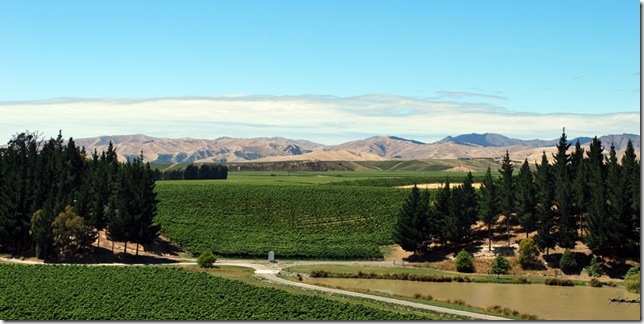 Spectacular view from the tower at the Highland Winery
Spectacular view from the tower at the Highland Winery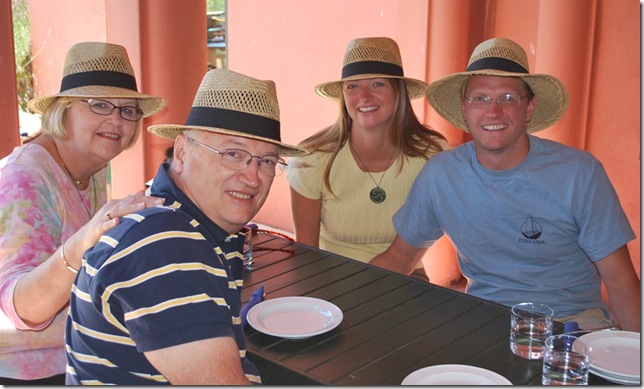 Our sun hats didn’t protect us from the farmer-tan!
Our sun hats didn’t protect us from the farmer-tan! 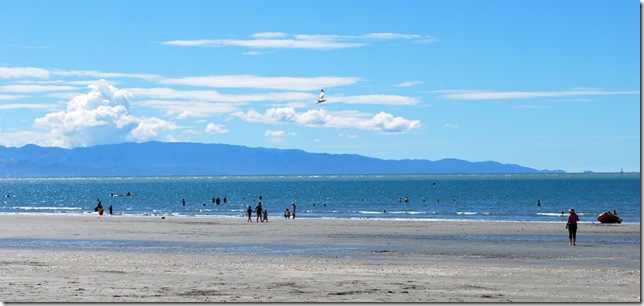 A gorgeous day at Abel Tasman National Park in Nelson
A gorgeous day at Abel Tasman National Park in Nelson
Once back in the North, we took a different route than before and were very surprised to find desert after just having driven through a forest! We were all amazed at how diverse the landscape is for such a small country and how rapidly it changes from one to the next. During the course of our trip, we saw what reminded us of Alaska, California (north and south), Colorado, New Mexico, Florida (white sand), and Hawaii, not to mention the fjordland. I think it’s safe to say that my parents were very pleased with their decision to come all this way, although the next time I see them will probably be a little closer to home!
As I am typing, we are on a ferry getting ready to “sail” (not sure why they call it that) back to the North Island. We have had a fantastic time touring the South with my parents, and I will try to catch up in the next couple of blogs.
Queenstown is a former gold mining town that now serves as one of the primary ski locales in NZ. The ski season doesn’t begin until April, but all year round the town is “buzzing”, we are told. Queenstown is touted as the adrenaline capital of NZ, featuring plenty of extreme adventure sports such as heli-biking (dropping onto the top of the mountain from a helicopter and biking down), lugeing, and skydiving. As for us, Mom had her heart set on bungee jumping, but we talked her out of it. Seriously, though, there was no shortage of activities suited to all our tastes. It was pretty cold and rainy for the first two days of our stay (very atypical for this time of year), which interfered with the view but not our good times. My parents had rented out a cozy vacation home in a nearby ski village, and we took full advantage of the fireplace, under-the-floor heating system, and dishwasher. Such luxury!
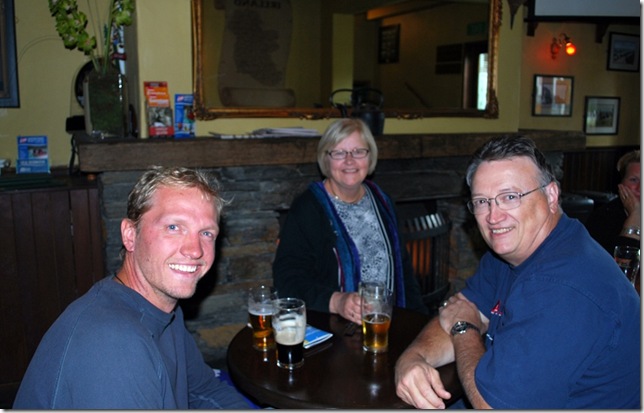 The Irish pub is always a good place to wait out the rain
The Irish pub is always a good place to wait out the rain
One of the sights in Queenstown that appealed to all of us was the Kiwi and Birdlife Park where we saw live kiwis being fed. Kiwis are flightless birds in the same family as the ostrich, They are nocturnal and somewhat rare due to predators (e.g., stoats and possums) introduced by settlers from other countries that attack the young. As a result, they are hard to get a glimpse of in the wild, but the Park had two of them on display in a room with infrared lights designed to simulate nighttime. They could be seen searching through the mulch for food using their very long beaks, at the ends of which are some of their most important assets, the nostrils. Our knowledgeable guide explained that one of the reasons that kiwis have become a national symbol is that they are such tough little guys. Once fully grown, they are highly resistant to attacks from land mammals due to their fierce kick and can survive in harsh conditions since they will eat anything. Other interesting facts include that 3-4 times per year, the adult female lays an enormous egg–the equivalent of a woman giving birth to a 37 lb newborn! After the birth, Mum goes off to mark her territory while Dad incubates the egg for 70-90 days, during which time he loses 20% of his body weight! How’s that for teamwork? We learned about some other fascinating animals’ behaviors and characteristics, but I better move on before this starts to sound like a term paper for Biology class!
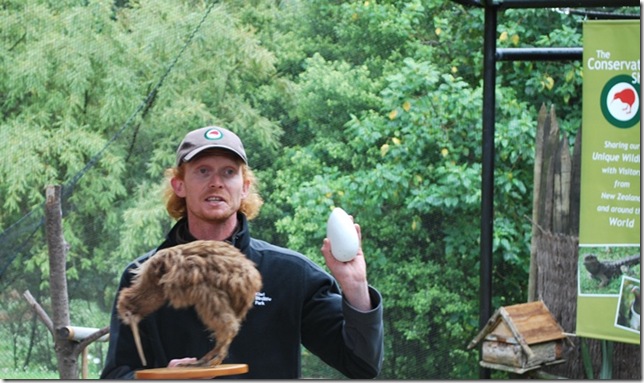 Model of a kiwi and her enormous egg
Model of a kiwi and her enormous egg
When the weather improved, we took a trip on the TSS Earnslaw, a vintage steamship originally launched in 1912 but in seemingly excellent condition today. We were able to go below and watch the stoker as he scooped coal into the fire, and we learned that, in the process of heating water to create the steam that drives three pressurized cylinders, a ton of coal is consumed in just an hour. Probably not a very “green” way to travel, but it was cool nonetheless.
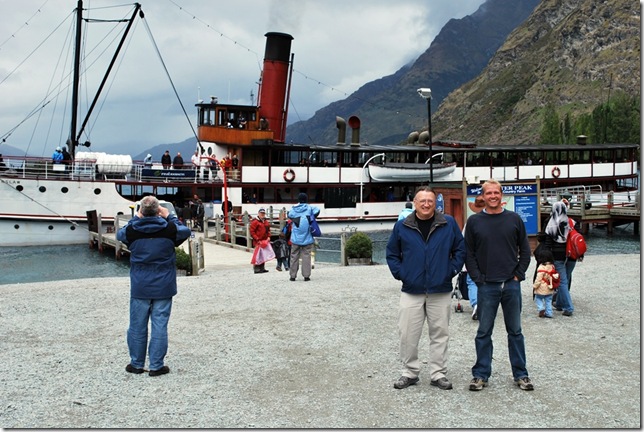 Disembarking from the TSS Earnslaw
Disembarking from the TSS Earnslaw
The Earnslaw took the four of us across the lake at the base of Queenstown’s mountains to our destination, the Walter Peak High Country Farm. Once at the Farm, we were met by our tour guide who was quite a character. He fed us one line after another while introducing us to the resident reindeer, sheep, cattle, and alpaca. We then had afternoon tea in a ranch-style homestead before heading back outside for the sheepdog demo (the border collie was unbelievably fast and efficient at mustering the sheep) and sheep-shearing. With 35 million sheep in NZ (9 per person!), wool is a very important national resource, and it was pretty impressive to see how effortlessly the shearer could maneuver and shear an initially reluctant Merino sheep.
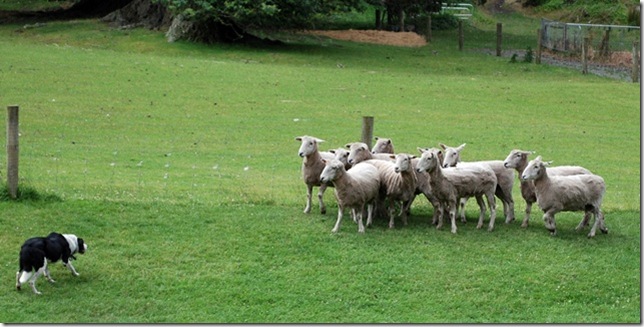 The sheep instinctively run away from the sheepdog
The sheep instinctively run away from the sheepdog
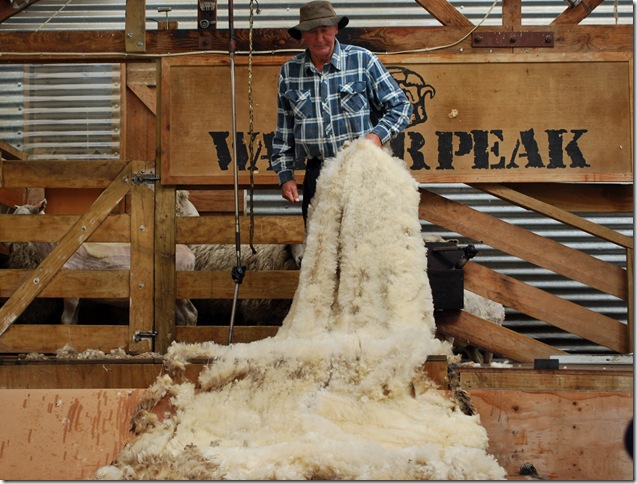 The wool from one sheep brings in about $7
The wool from one sheep brings in about $7
The following day we got up early and drove 5 hours to Milford Sound in the Fjordland National Park. As we climbed up into the mountains, there were plenty of scenic vistas, and we stopped several times for photos (and one snowball fight). Once we had to stop for a flock of sheep in the road! The shepherd could have used some more sheepdogs, as he was trying pretty unsuccessfully to corner the strays with his truck, chase them down by foot, and carry them back to the truck!
Milford’s name is a misnomer, since a “sound” is create by a flooded river, whereas Milford is a fjord—a group of steep cliffs and u-shaped valleys created by the gradual grinding down of rock by a glacier millions of years ago, the valleys of which have now been filled in by the sea. The result is spectacular and can be viewed only by sea or by air. We opted to “set sail” on a large scow. (The sails were just for show, since, in the absence of a keel, the scow would move sideways under sail alone.) The winds coming down from the cliffs are often said to blow over 100 km/hour, but the weather the best it had been in 2 weeks on the day we were there. It was a bright, sunny day as we motored around the fjords to view several waterfalls, striations in the cliffs created by the glaciers and “tree avalanches”, and fur seals lounging around on the rocks. The boat took us out into the surprisingly calm Tasman Sea before heading back into the fjords, and the view on the way back was even better.
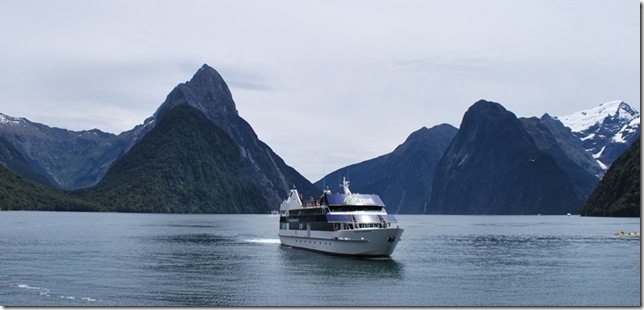 Mitre Peak is the most well known feature of Milford Sound
Mitre Peak is the most well known feature of Milford Sound


